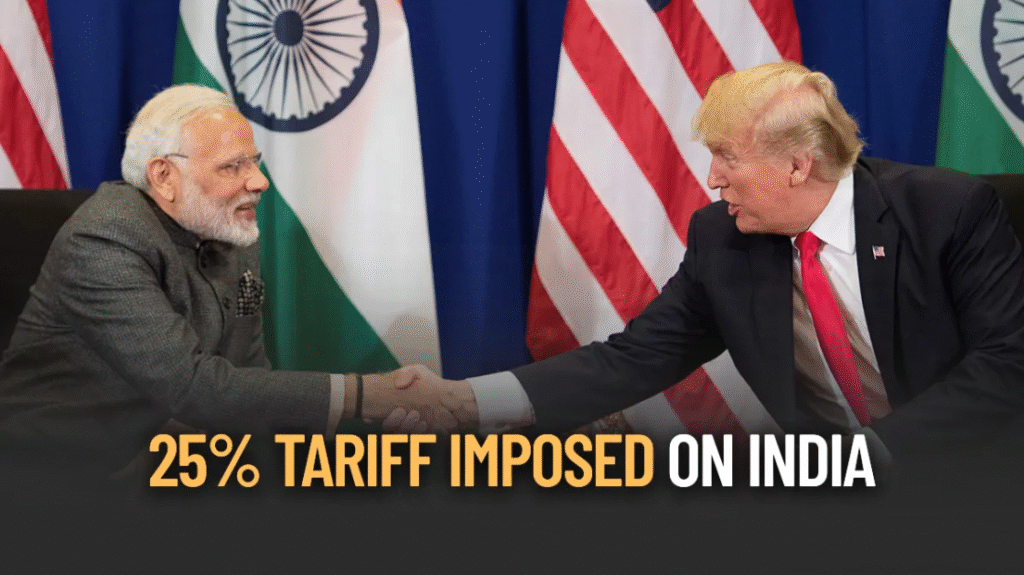In a dramatic escalation of trade tensions, U.S. President Donald Trump announced a 25% tariff on Indian imports, effective from August 1, coupled with an unspecified penalty tied to India’s continued procurement of Russian energy and arms.
Despite referring to India as a “friend,” Trump accused it of maintaining some of the highest tariffs globally and imposing oppressive non-monetary trade barriers on U.S. goods.
🔍 Policy Details & Strategic Context
- Tariff Rate: A flat 25% duty on most Indian exports, replacing previous expectations of a 20–25% range.
- Penalty Clause: Includes additional charges for India’s importation of Russian oil and arms, reflecting rising U.S. pressure over India’s defense partnerships amid the Ukraine war.
- Strategic Trigger: Part of Trump’s “liberation day” tariff rollout aimed at reversing trade deficits and punishing countries he deems protectionist.
🧾 Impact Analysis: Trade, Finance & Legal Considerations
📉 Economic & Export Effects
Citi Research estimates India could lose up to $7 billion annually in U.S. export revenues from the tariff alone. India’s pharmaceuticals, auto parts, textiles, and gemstones—some of its highest-value exports—are expected to suffer the greatest impact.
🤝 Trade Deal Setback
The announcement disrupts bilateral trade efforts. Despite months of negotiations following Narendra Modi’s U.S. visit in February 2025, no formal agreement was reached. Trump’s announcement effectively freezes talks as a August 1 deadline arrives.
⚖️ Legal Implications
Experts note that while the tariff itself is unilateral, additional penalties may be enshrined under frameworks like CAATSA (Countering America’s Adversaries Through Sanctions Act), which conditions consequences on countries sourcing Russian defense or energy. This could raise legal exposure for entities conducting defense deals.
💬 Reaction in India: Government, Industry & Opposition
- Government stance: India has not formally responded yet, maintaining diplomatic tone while awaiting U.S. engagement. The Commerce Ministry has declined comment so far.
- Trade expert views:
- Madhavi Arora (Emkay Global) sees the move as geopolitical leverage more than economics.
- Anen Banerjee (PwC) expects tariffs to be short-lived since trade talks are expected to resume in August.
- Nilesh Shah (Kotak AMC) criticized the unpredictability, calling for urgent economic resiliency.
- Agnishwar Sen (EY India) called it unfortunate but sees continuing dialogue as vital.
- Political dissent: Congress leaders sharply criticized Prime Minister Modi, accusing him of failure due to a close rapport with Trump yielding no trade protection. Jairam Ramesh said, “India is now paying the price of Modi’s friendship”.
🔍 Broader Implications & Legal Precedents
⚖️ International Trade Jurisprudence
Trump’s action is legally valid under U.S. trade laws, but India may challenge additional penalties if they infringe upon WTO norms or bilateral agreements.
📜 Impact on Trade Agreements
Imported tariffs may nullify any impetus for a forthcoming India–U.S. trade agreement. India emphasized it will not negotiate under duress, signaling diplomatic friction.
🏛️ CAATSA & Sanctions Pathways
Further measures could invoke secondary sanctions under CAATSA, although India has enjoyed selective waivers in the past. Continued defense ties with Russia leave India legally exposed if further penal provisions are activated.
🧠 Summary & Legal Outlook
| Parameter | Implication |
|---|---|
| Tariff impact | Higher cost for Indian exports to the U.S. |
| Trade negotiations | Bilateral deal prospects jeopardized |
| Legal exposure | CAATSA sanctions possible if defense/energy purchases continue |
| Domestic politics | Opposition mounts pressure on Modi’s foreign policy |
| Economic strategy | Urgent need for diversification, competitiveness, and negotiation |
✅ Conclusion
This sudden imposition of a 25% U.S. tariff on Indian exports—plus a penalty tied to defense and energy ties with Russia—marks a turning point in India–U.S. trade dynamics. Though negotiations remain technically alive, the move underscores rising U.S. legal leverage under domestic trade laws. India’s economic interests now hinge on diplomacy, rapid negotiations, and potential legal recourse to mitigate disruptions to its export sector and defense agreements.
To read more Indian Laws and news, visit Legal Guide India



